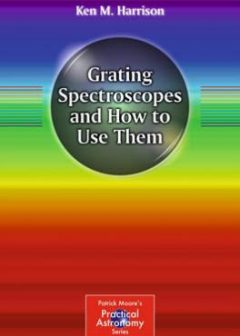Grating spectroscopes and how to use them
| By Ken M. Harrison | Reviewed by David Arditti |
| Springer 2012 | xvii + 167 pages |
| Price £31.99 (pbk) | ISBN:978-1-4614-1396-7 |

This book aims to be a comprehensive beginners’ guide to amateur spectroscopy using the most inexpensive equipment on the market, the replica diffraction grating in a 1.25-inch filter-threaded cell, particularly the grating most easily available currently, the Paton−Hawkesley Star Analyser. The author would appear to be very well-qualified to cover the subject, being a mechanical engineer with an interest in optics who has been building spectroscopes for 50 years. He has already written a related book for Springer, Astronomical Spectroscopy for Amateurs (2010).
The topics covered range over the theory of spectroscopy, practical combinations of simple equipment – telescopes, adaptors and cameras (including making custom components) − taking images and analysing them, interesting objects to observe, and suggestions for areas of research which are possible using this limited equipment. The worthy aim of the author is to take the reader right from the basics of the subject, in a hands-on, practical way, through to being able to do scientifically useful spectroscopy.
To a considerable extent he succeeds in this, and personally, as a beginner in spectroscopy, I acquired much useful information from this book. Nevertheless I also found quite a few problems with it. For one thing, the writing is often unclear and the explanations muddled, with signs of poor copy-editing. Simple English errors (such as the use of ‘i.e.’ where the intention is ‘e.g.’), small technical errors (such as codex instead of codec, p.11), and sloppinesses such as ‘sec arc’ meaning (unexplained, same page) ‘seconds of arc’, abound.
The basic physical explanations can be distressing. For example, on p.3 we read: ‘Prisms disperse the light due to the type of glass they are made from and the shape of prism used’ – a sentence which combines clumsy English with a failure to in any way explain dispersion in media. In the next paragraph, we read ‘The speed of light is fixed and unchanging’, though of course dispersion in media depends on change of phase velocity of light; then in the next paragraph, ‘Short wavelengths appear to us as blue; violet and much longer wavelengths look red.’ Violet looks red? I beg your pardon?
Equally confused are some explanations of how actually to do things. In the Quick Start Guide (p.xvi) we are told to ‘find and focus the spectrum as per above’ when above there has been no mention of how to do this. Then a few lines later occurs: ‘Remove the eyepiece and insert the grating/nosepiece/camera… Look into the grating and rotate it to align the image of the CCD chip.’ Sorry, align what with what? And how can you look into the grating after you have inserted it into the telescope? Actually, the author does explain this properly later, in Chapter 2 (he means ‘align the lines on the grating with the edges of the chip’), but why put a confused summary of the technique at the beginning of the book?
On the positive side, the many clear photographs of equipment are very helpful, as are the many colour photographs of spectra and screenshots from calibration and analysis software. Detailed explanations of how to use software, particularly free packages such as IRIS and Visual Spec, will be useful to anyone newly exploring this area but not wanting to spend much money.
I am not aware of any other book that covers this subject from this perspective, and it therefore usefully fills a gap, so I can actually recommend it, despite the sometimes patronising style, and the solecisms mentioned above.
Dr David Arditti is a Council Member of the BAA and a well-known astronomical imager.
| The British Astronomical Association supports amateur astronomers around the UK and the rest of the world. Find out more about the BAA or join us. |
